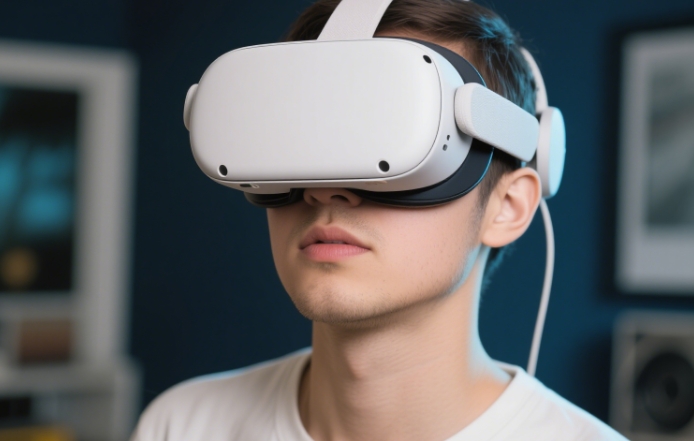




2025-04-13
Stimulated by the launch of Apple's new product Vision Pro, research institutions predict that the global shipment of Display screens will reach 16 million units in 2024, representing a year-on-year growth of more than 7%. Among them, the market share of Micro OLED display screens will be 10.7%.
There is more data indicating that the shipment volume of Micro OLED panels in the global XR industry was approximately 820,000 units in 2023. It is expected that the global demand for Micro OLED screens in the XR field will increase again in 2028.
Why does OLEDoS Display have such huge market potential? This starts with the three irreplaceable technological advantages of OLEDoS Display.

In terms of technical parameters such as pixel density, response time, contrast ratio, and color gamut, OLEDoS Display all shows superior performance.
Among them, OLEDoS Display has a very high pixel density (for example, a 1.33-inch 4K silicon-based Micro OLED Display produced by a certain manufacturer has an ultra-high resolution of 3840×2160), and the color gamut range is extremely high.
It integrates a CMOS drive circuit composed of tens of millions of transistors, having a very high pixel density (PPI), which can reach up to 2000 PPI. Therefore, it is highly suitable for near-eye devices and VR devices, and can provide users with extremely delicate image display.
In addition, its self-luminous characteristic enables it to precisely control the brightness of each pixel (some 0.49-inch Micro OLEDos displays can reach 1800 nits, and 0.6-inch OLED displays can reach 1500 nits.). For instance, when displaying black, the pixels can be completely turned off, making the dark parts darker and resulting in a high contrast ratio, which has obvious performance advantages compared with LCD, LED and PMOLED. Thus, it is suitable for use in night vision goggles, enabling users to see the details in dark environments more clearly.
The response speed of OLEDoS Display is extremely fast, and the response time of some products is as short as within 1 millisecond. Therefore, its characteristics can be utilized to display fast-moving targets in electronic sights and high-speed action scenes in VR games.
OLEDoS Display is composed of SM-OLED processed by small molecule vapor phase and polymer/liquid P-LED. As a result, it has the advantages of being thin (the thickness of some products is only 100 nanometers) and light in weight.
Due to these advantages, it is suitable for wearable devices, reducing the sense of weight for users. For example, wearable near-eye display devices have been successively launched into the market in recent years. These devices, which are lighter in weight and more comfortable to wear, have received widespread attention from consumers.
At the SID Display Week 2024, a certain manufacturer showcased an OLEDoS display panel for VR with a brightness as high as 10,000 nits, and the area is only 1.3 inches.
In addition, the OLEDoS panel for 1.3-inch smartwatches produced by this manufacturer not only has a 4K ultra-high-definition resolution but also is much lighter in weight than other products. However, this manufacturer has not disclosed the specific weight of this product.
When displaying dark-colored images, the pixels of OLEDoS Display can be turned off, which can greatly reduce power consumption. For example, in the OLEDoS Display of the portable thermal imaging system for body temperature screening developed by Fraunhofer FEP, the power consumption of the entire system is less than 5 milliwatts.
The measurement results of the proof-of-concept array implemented in TSMC 65-nanometer technology show that by adopting single-capacitor bank energy recovery technology, dual-capacitor bank technology, and direct energy recovery technology, the power consumption can be reduced by more than 24% respectively.
This is not only helpful for energy conservation and environmental protection but also contributes to extending the battery life of devices, making users more willing to wear them and reducing the number of charging times.
For situations where devices need to be used in outdoor environments (such as disaster relief, firefighting, or troubleshooting in industrial plants), this advantage is irreplaceable.
With its exclusive FSL technology, MOT provides global manufacturers with solutions that combine high performance, low power consumption and cost-effectiveness.
It not only achieves the high performance and low power consumption of silicon-based OLEDs, but more importantly, solves the biggest problem faced by silicon-based OLEDs — the cost issue, clearing the obstacles for their mass production and reducing the overall costs for VR and AR manufacturers.
Contact:https://www.micro-oledtech.com/contact/
Unlike LED displays which focus on traditional commercial displays, micro OLEDs will focus on more high-tech fields. With the development of science and technology, the cost of OLEDoS Display is gradually decreasing, and the technology is becoming increasingly mature, making it an important display component for many portable wearable devices and advanced devices. Relying on the three irreplaceable advantages of OLEDoS Display, it will bring people a more wonderful visual experience.